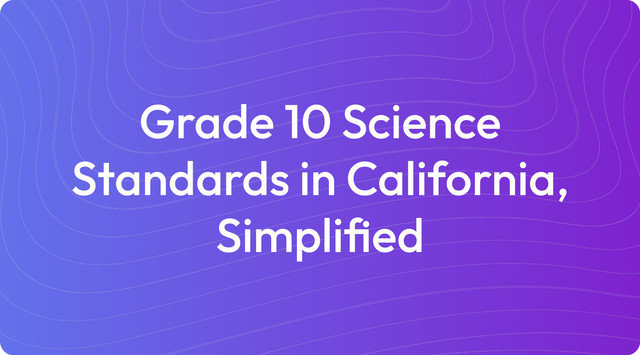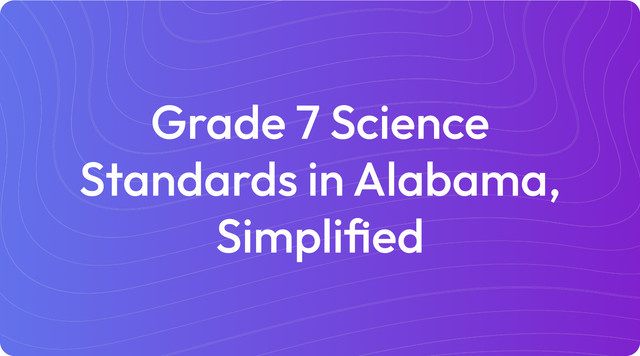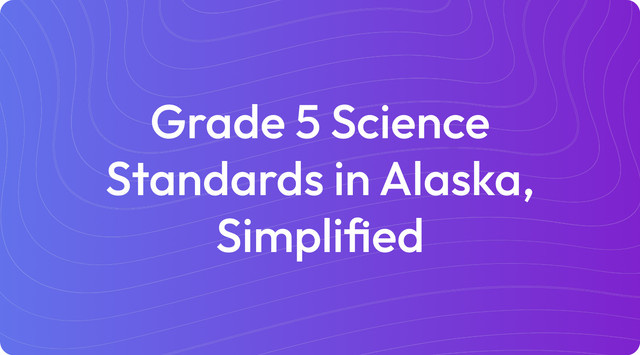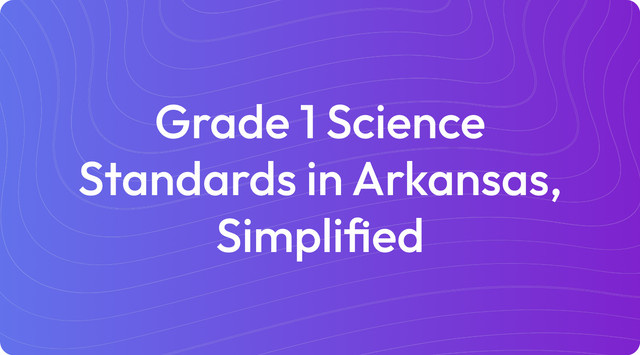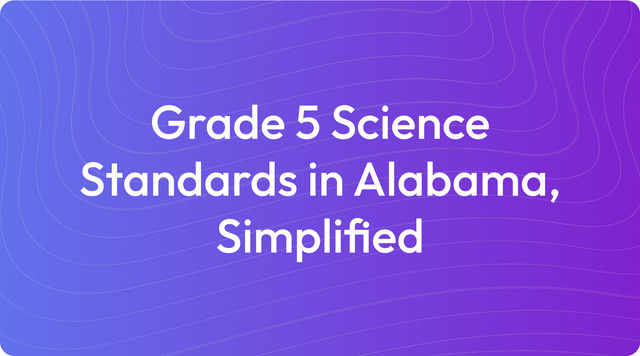Grade 8 Science Standards in Arkansas, Simplified
Chemistry, genetics, and Earth processes in Grade 8 science in Arkansas—view simplified standards now on TeachShare!
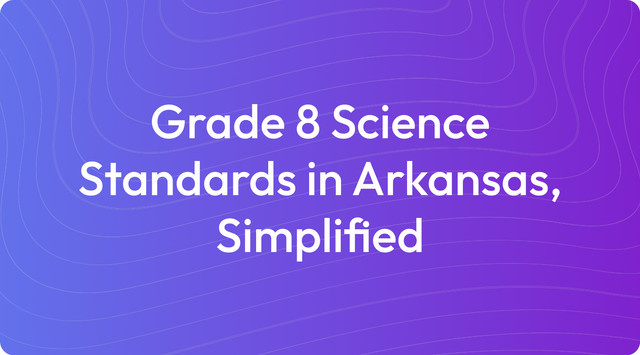
We understand that working with state standards is a significant part of your job. Our goal is to provide resources that make this process more direct and manageable. We're here to help you connect standards to your curriculum planning and instruction.
Education standards are learning goals that outline what students are expected to learn in each subject and grade. They provide clear benchmarks for student progress but do not dictate specific teaching methods or curriculum. For example, the Grade 8 Science Standards in Arkansas define learning domains like Physical Science and Life Science, but leave decisions about instructional materials and lesson plans to local educators.
What Are Grade 8 Science Standards in Arkansas?
The Grade 8 Science Standards in Arkansas, aligned with the Next Generation Science Standards (NGSS), emphasize three-dimensional learning. These standards are organized across the domains of Physical Science (PS), Life Science (LS), Earth and Space Science (ESS), and Engineering Design (ETS). Here is an overview of the standards:
Physical Science (PS):
- MS-PS1-2: Analyze and interpret data on properties of substances to determine if a chemical reaction occurred.
- MS-PS1-3: Gather and interpret information about how synthetic materials impact society.
- MS-PS2-3: Investigate and model how forces are involved in electric and magnetic interactions.
- MS-PS4-2: Develop models to describe wave behavior and how waves transfer information.
Life Science (LS):
- MS-LS1-4: Use models to describe how food is rearranged through chemical reactions to release energy for life processes.
- MS-LS2-1: Analyze data to show how resource availability affects organisms and populations in ecosystems.
- MS-LS4-4: Construct explanations for how genetic variations increase an organism's chances of survival and reproduction.
Earth and Space Science (ESS):
- MS-ESS1-3: Analyze data to determine the scale properties of objects in the solar system.
- MS-ESS2-2: Construct explanations for how geoscience processes (e.g., plate tectonics) shape Earth's surface.
- MS-ESS3-4: Construct arguments supported by evidence about how human population growth impacts Earth’s systems.
Engineering Design (ETS):
- MS-ETS1-1: Define problems solvable through engineering.
- MS-ETS1-3: Analyze data from design tests to determine the best solution.
The framework for these standards is guided by the Next Generation Science Standards and the Division of Elementary and Secondary Education.
Key Tested Standards
For Grade 8 Science in Arkansas, the key tested standards often focus on foundational concepts, data analysis, and real-world applications. To help you prepare your students, we've highlighted the standards that are frequently tested. Likely tested standards include:
Physical Science (PS):
- MS-PS1-2: Analyze data on the properties of substances to determine if a chemical reaction has occurred
- MS-PS2-3: Investigate and create models to explain the interactions between electric and magnetic forces
- MS-PS4-2: Develop models to describe how waves behave and transfer information
Life Science (LS):
- MS-LS1-4: Use models to show how food is rearranged through chemical reactions to release energy for life processes
- MS-LS2-1: Analyze how the availability of resources affects organisms and populations within an ecosystem
- MS-LS4-4: Construct explanations for how genetic variations improve an organism's chances of survival and reproduction
Earth and Space Science (ESS):
- MS-ESS1-3: Analyze data to compare the scale and properties of objects in the solar system
- MS-ESS2-2: Explain how geoscience processes, like plate tectonics, shape the Earth's surface
- MS-ESS3-4: Construct arguments with evidence about how human population growth impacts Earth’s systems
These standards are heavily focused on modeling, data analysis, and argumentation, which are key skills for assessments. This information is based on guidance from the Next Generation Science Standards and the Arkansas Division of Elementary and Secondary Education.
Example Learning Objectives for Unit Planning
Learning objectives translate broad standards into specific, measurable goals for your students. They clarify what students should be able to do by the end of a lesson, which helps in designing focused instruction and assessments.
Here are student-friendly learning objectives for two Grade 8 Science standards:
Standard: MS-PS1-2 (Analyze data to determine if a chemical reaction occurred)
- I can identify evidence of a chemical reaction, such as gas production, color change, or temperature change.
- I can analyze data to compare the properties of substances before and after a reaction.
- I can explain how changes in properties show whether a new substance has formed.
Standard: MS-LS2-1 (Resource availability affects populations in ecosystems)
- I can explain how the availability of resources, like food or water, affects the size of a population.
- I can analyze data to show how changes in resources impact an ecosystem.
- I can predict what happens to a population if resources increase or decrease.
Key Changes & Updates
The Grade 8 Science Standards in Arkansas were updated in 2015 to align with the Next Generation Science Standards (NGSS). This update introduced a significant shift toward three-dimensional learning, moving instruction from memorization to active, inquiry-based problem-solving. The goal is to help you prepare students with critical thinking skills by connecting scientific concepts to real-world applications.
This framework emphasizes doing science, not just learning about it. Here are the key updates:
- Three-Dimensional Learning: An approach that integrates scientific practices, core content knowledge, and broad concepts that connect different scientific fields.
- Focus on Real-World Phenomena: Instruction is now built around observable events and questions, making learning more concrete and applicable.
- Performance-Based Expectations: Students are assessed on their ability to apply knowledge by developing models, analyzing data, and constructing arguments.
- Integration of Engineering Design: The standards now include engineering principles, encouraging students to design and test solutions to problems.
Create with TeachShare
We know that turning these standards into engaging lessons takes time and effort. Our platform is designed to help you build high-quality, standards-aligned materials quickly, so you can focus more on your students and less on resource creation. Start creating standards-aligned instructional resources with TeachShare now.
Frequently Asked Questions
What core topics will my 8th-grade students learn?
The Arkansas standards for 8th-grade science are built around four key areas. Here’s a look at what your students will explore:
- Physical Science: Investigating chemical reactions, forces, and how waves behave
- Life Science: Understanding ecosystems, how organisms use energy, and genetic diversity
- Earth and Space Science: Learning about geological processes, our solar system, and the effects of human activity on the planet
- Engineering Design: Applying scientific knowledge to design and test solutions for real-world challenges
What is three-dimensional (3D) learning?
Three-dimensional learning is an approach that helps students connect scientific ideas in a meaningful way. It weaves together three key elements:
- Science and Engineering Practices: The “doing” part of science, like conducting investigations and analyzing data
- Crosscutting Concepts: The big ideas, such as cause and effect or patterns, that link different areas of science
- Disciplinary Core Ideas: The essential content knowledge within physical, life, and earth sciences
By combining these, students learn to think like scientists and apply their knowledge to solve problems, rather than just memorizing facts.
How can I include hands-on activities that align with these standards?
The standards are designed to get students actively involved in science. You can bring the curriculum to life with activities like these:
- Conducting experiments to observe chemical changes firsthand
- Building models of ecosystems to see how resource availability affects different populations
- Challenging students to design and present solutions that address human impacts on the environment
What kind of assessments work well with these standards?
Assessments should reflect the hands-on, three-dimensional nature of the standards. Instead of relying only on traditional tests, you can measure student understanding through:
- Performance Tasks: Ask students to create a model of a food web or demonstrate wave behavior
- Lab Reports: Have them document their observations and analyze the results from an experiment
- Data Interpretation: Provide graphs or charts about population dynamics and ask students to draw evidence-based conclusions
How do these 8th-grade standards set students up for success in high school?
These standards do more than just teach 8th-grade content; they build the foundational skills students need for more advanced science courses. By the time they reach high school, your students will have experience with:
- Analyzing and interpreting data from various sources
- Creating and using scientific models to explain phenomena
- Building arguments supported by evidence
These abilities are crucial for tackling high school chemistry, biology, and physics with confidence.
Answer


